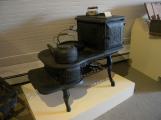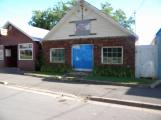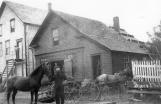1
Service IndustriesThe ease today in which we travel, communicate, make and purchase whatever we need, and the general convenience of our lives make it easy to forget that 120 years ago, for people on the North Shore, it was a very differnt existence. Self sufficiency and a reliance upon neighbours was necessary to survive. With increasing population, the arrival of skilled trades, such as blacksmihs, wheelwrights, carpenters, tanners, tinsmiths, iron foundries, canneries, cheese factories, the telegraph, stagecoach, railway, hotels, tailors, dressmakers and shoemakers, made a considerable difference to the area. The automobile, mass production, and the finding of oil changed everything yet again, so little remains of the service industries between 1820 and 1920.
2
8) SERVICE INDUSTRIES - Ferries, Wallace, Nova Scotia, CanadaEarly 1900's
Wallace, Nova Scotia, Canada
 Credits:
Credits:Wallace and Area Museum
Ellen Millard
3
FerriesAlmost from the time the communities of Wallace and North Wallace were settled, a ferry connected them. The two ladies in the small boat are in the ferry, but a barge is being used to transport a horse and wagon.. With the building of the bridge connecting the two areas, the ferry was no longer necessary
4
Malagash/Tatamagouche Ferry, Tatamagouche, Nova Scotia, Canada1920
Tatamagouche, Nova Scotia, Canada
 Credits:
Credits:Arthur Treen
5
.The Tatamagouche to Malagash ferry was started by the merchants of Tatamagouche and later taken over by the government.Leaving Patterson's Wharf, Tatamagouche, on Tuesdays,Thursdays and Saturdays, it ran three times a day to Malagash Wharf. The trip lasted half an hour, leaving at 10am with the last trip at 4pm. It cost 25 cents for adults and 10 cents for children.
The ferry was 25ft ( 7.5m) long, with the engine in the front and seats on both sides. It carried 25 people. Along the sides were canvas curtains that could be pulled in rough weather to give protection. Beldon Joudrey was the ferryman; others at some time were Ed McLellan, Warren Millard and Sandy Joudrey
Children would go to Malagash to swim, the girls wearing old dresses with high collars and long sleeves, as they had no swimsuits; adults took wheelbarrows to carry purchases, for example, cheese from the Malagash cheese factory, which was a third of a mile (.54 km) from the wharf.
It is recorded that the Malagash wharf was built in 1901 by Baxter Robinson from Fox Harbour - he hired men to clear the large trees to provide a right of way to the wharf site.
6
The "Heather Belle", Brule, Nova Scotia, Canadalate 1800's
Brule, Nova Scotia, Canada
 Credits:
Credits:North Shore Archives CSHC
Don Beeler
7
The' Heather Belle' ran on Wednesday and Friday evenings at 8pm, to Brule; Monday and Thursday mornings at 9am to Pictou. and lists of passenger names were published in the local paper.The ship had an occasional excursion, for example, the following excerpt from a Charlottetown ( PEI ) advertisement:"Cricket Match in Truro
Cheap Excursion to Brule and Pictou. The Heather Belle will leave Charlottetown on Thursday morning at usual hour. Parties desiring to view the match between the Halifax and Charlottetown Clubs to be played at Truro on Friday the 6inst will have the opportunity of doing so, by the above vessel.
Fares to and from the above port: General 10¢, Lady and Gent 9¢ each; 3 and upwards of a family 8¢ each.
F. W. Hales, Sec'y
Ch'town Sept 12, 1864"
On August 31, 1864, four men alighted from a stage coach at Brule Wharf , having travelled from Halifax by train to Truro. The 'Heather Belle' was boarded by Adam Archibald of Truro, Jonathan McCully of Cumberland County, William Henry of Halifax and Premier Charles Tupper of Amherst. They were on their way to the Charlottetown Conference, and would become part of a group later known as 'The Fathers of Confederation'.
Robert Dickey of Amherst, who originally opposed Confederation but later changed his mind, had travelled to Charlottetown the previous day.
The steamship was considered ideally built as a blockade runner for the American Civil War. She was of shallow draught, built low to the water, and had no masts. She burned anthracite coal, and would have been difficult to see. Before she became involved in the war, however, the ship was trapped in the ice and was not freed in time to be of any use.
8
Morrill Foundry, Brule, Nova Scotia, Canada1911
Brule, Nova Scotia, Canada
 Credits:
Credits:North Shore Archives CSHC
Don Beeler
9
The Brule Iron Foundry had two cast iron ventilators at the peak which carried off the fumes from the furnace. Charcoal was used for fuel (although there is a reference to coke being used). A treadmill, belted to a blower, and operated by one horse, supplied a forced draft of air for the furnace. In the later days of the foundry the treadmill was replaced by a six horsepower gasoline engine, probably the first gasoline-powered engine to be used in the community. A cupola was a furnace that melted scrap iron, collected by Morrill from around the countryside.As well as the stove the foundry produced ploughshears, pots, kettles,shoemakers lasts, the iron work for school desks and a variety of everyday objects used in the community A wood model was made of an item and imprinted into special sand; the wood object removed and molten iron poured into the space to mske a cast iron replica.
In 1871, a census reported William Morrill as a moulder, producing mostly wood moulds for casting iron objects. It is possible that he started this industry in the area with the foundry behind his house to support the shipbuilding industry. He purchased the land from John Mockler in 1866.
Noah Morrill died in 1911 and the business ceased.
10
Brule Stove, Tatamagouche, Nova Scotia, Canada1898
Tatamagouche, Nova Scotia, Canada
 Credits:
Credits:Sunrise Trail Museum.CSHC
11
Blacksmith Shops:Along this area of the North Shore there were numerous blacksmiths, at least 56; many were small scale, combining smithy with farming. Some were also associated with shipbuilding, and some with the carriage industry.
New Annan
David Chalmers and his son - 1905 - 1919 (possibly with Johnny Larson) were blacksmits, also Jordy Matheson
Corktown (originally an Irish settlement but no longer in existance) had David Aikenhead as a blacksmith in 1838
Brule Corner
George McLanders - 1892 - 1910
In 1916 there was a blacksmith shop on the wharf side of the main road, which served the wharf, local carriage shop and stables.
The Morrell Foundry had a blacksmith shop
12
Blacksmiths: Tatamagouche, Nova Scotia, Canada1 August 2010
Tatamagouche, Nova Scotia, Canada
 Credits:
Credits:S. Brinkhurst
13
Between 1835 and 1935, Tatamagouche had at least 14 blacksmiths; there were two or three still working in living memory, and the sites known, although they are under flower gardens now!James Ramsay between 1847 and 1940, did a wide variety of work, from making eel traps, to repairing bridges in the area, to working on tires for waggons.
Over the years there were:
Edward Kent - 1823, who went into ship building in 1851
James Grant -1840,
Robert Brydon -1882 - 92
James Mattatall- 1892
Andrew Urquhart- late- 1800s
George Douglas -1882 - 1909
James Ramsey- 1905 - 09
Alexander Campbell- built a blacksmiths's shop to serve the shipyards, where the old road crosses the bridge, according to map of 1874. The same map shows a blacksmiths on the water side of the road beyond the town hall, on a side street leading to the water, and one by the hotel stables, on the site of the former Sunrise Trail Museum.
Gordon Fraser- 1910-1929 took over William Bryden's business of 1835
Smith McPherson- 1920-1949
Ben Langille- 1906-1934, opposite Smiths Farm Equipment
Thomas Bonnyman - 1902-1926,
14
George Douglas Blacksmith, Tatamagouche, Nova Scotia, Canada1900
Tatamagouche, Nova Scotia, Canada
 Credits:
Credits:North Shore Archives. CSHC